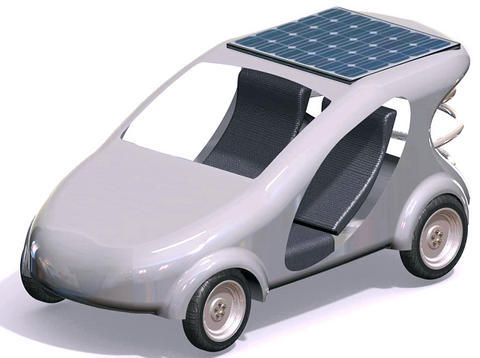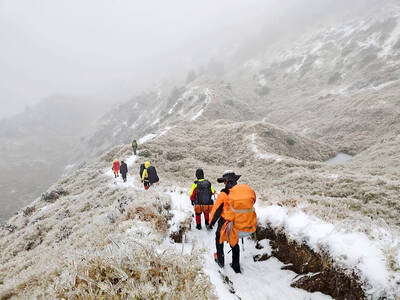For commuters worried about rising fuel prices, greenhouse gas emissions and the headache of finding parking, a compact solar-powered vehicle may be the answer -- and could be on the market within a year.
"At a time when carbon emission reduction and fighting global warming are top priorities of governments and people, a wholly solar-powered car would offer a good alternative for the green-minded," the car's research and development team leader, Ay Herchang (
A prototype of the car was inspired by the Apollo, a solar car Ay and a team at National Kaohsiung University of Applied Sciences built to compete in races such as the Australian World Solar Challenge (WSC), the professor of engineering said.

GRAPHIC COURTESY OF NATIONAL KAOHSIUNG UNIVERSITY OF APPLIED SCI
"As [our team] has done quite well in the past 10 years at international solar car races -- this year ranking second out of more than 50 cars at the WSC -- we decided two years ago to broaden our advanced solar technology applications and make a car for the consumer market," he said.
The WSC, which celebrated its 20th anniversary this year, requires participants to race solar-powered vehicles 3,000km across various Australian terrains, he said.
Several obstacles had to be overcome to turn the one-seater solar race car capable of speeds up to 145kph, into a domestic consumer vehicle, he said.
"With added seats and passengers, the car was bigger and heavier, which compromised its speed," he said, adding that driving on the nation's highways would be out of the picture.
A light-weight model is best, Ay said, as it requires less battery power to maintain speed. When there is a lack of sunlight, the car runs on a solar-charged battery.
The final product of the team's tweaking is a 250kg two to three-seater that travels at up to 70kph and comes with a price tag of about NT$800,000, he said. At 3m by 1.3m, it's easy to park, too.
The battery can be charged with just a few hours sunlight and can power the car for three hours.
On vehicle safety, Ay said: "Parts of the car will be made with Nomex honeycomb, a material widely used in aircraft and aerospace components for its high strength, excellent impact and fire resistance as well as its light weight."
Though solar-powered city roamers have already debuted on some European markets, the made-in-Taiwan version is half the weight and costs half the price, Ay said.
"Moreover, in Taiwan, with our abundance of sunlight, this car is a viable solution for us to save gas and the environment," Ay said.

Trips for more than 100,000 international and domestic air travelers could be disrupted as China launches a military exercise around Taiwan today, Taiwan’s Civil Aviation Administration (CAA) said yesterday. The exercise could affect nearly 900 flights scheduled to enter the Taipei Flight Information Region (FIR) during the exercise window, it added. A notice issued by the Chinese Civil Aviation Administration showed there would be seven temporary zones around the Taiwan Strait which would be used for live-fire exercises, lasting from 8am to 6pm today. All aircraft are prohibited from entering during exercise, it says. Taipei FIR has 14 international air routes and

The Ministry of National Defense (MND) today released images of the military tracking China’s People's Liberation Army (PLA) movements during the latest round of Chinese drills around Taiwan. The PLA began "Justice Mission 2025" drills today, carrying out live-fire drills, simulated strikes on land and maritime targets, and exercises to blockade the nation's main ports. The exercises are to continue tomorrow, with the PLA announcing sea and air space restrictions for five zones around Taiwan for 10 hours starting from 8:30am. The ministry today released images showing a Chinese J-16 fighter jet tracked by a F-16V Block 20 jet and the

Snow fell on Yushan (Jade Mountain, 玉山) yesterday morning as a continental cold air mass sent temperatures below freezing on Taiwan’s tallest peak, the Central Weather Administration (CWA) said. Snowflakes were seen on Yushan’s north peak from 6:28am to 6:38am, but they did not fully cover the ground and no accumulation was recorded, the CWA said. As of 7:42am, the lowest temperature recorded across Taiwan was minus-5.5°C at Yushan’s Fengkou observatory and minus-4.7°C at the Yushan observatory, CWA data showed. On Hehuanshan (合歡山) in Nantou County, a low of 1.3°C was recorded at 6:39pm, when ice pellets fell at Songsyue Lodge (松雪樓), a

NO SHAME IN RETREAT: Hikers should consider turning back if the weather turns bad or if they do not have sufficient equipment, the Taroko park headquarters said Two people died of hypothermia over the weekend while hiking on Hsuehshan (雪山), prompting park authorities to remind hikers to bring proper equipment and consider their physical condition before setting out in the cold weather. Temperatures dropped over the weekend, bringing snow to high altitudes in Shei-pa National Park. One hiker, surnamed Lin (林), who on Friday was traveling with a group of six along the Hsuehshan west ridge trail, lost consciousness due to hypothermia and died, the Shei-pa National Park Headquarters said. On Saturday, another hiker, surnamed Tien (田), in a group of five on the southeast of the west